Environmental Conservation in the Tibetan Plateau Region: Lessons for China’s Belt and Road Initiative in the Mountains of Central Asia
Abstract
1. Introduction
2. Methods
3. Background
3.1. Major Geographies
3.2. Protected Areas in China
4. Results
4.1. Recent Developments in Conservation and Sustainable Use of Tibetan Rangelands (Case Study)
4.1.1. Community Conserved Areas and the Development of Local Civil Society
4.1.2. Sanjiangyuan National Nature Reserve and Community Co-Management
4.1.3. Community Associations and Cooperatives
4.1.4. Development of China’s New National Park System
4.2. Lessons Learned for Environmental Conservation, 1998–2018
4.2.1. Comprehensive, Integrated Perspectives Must Be Adopted
4.2.2. Conservation Champions Are Major Players in Bringing Change
4.2.3. Community Level Sense of Ownership and Commitment are Essential
4.2.4. Community Participation Increases Sense of Responsibility and Effectiveness
4.2.5. Community Co-Management Approaches Strengthen Actions and Build Trust
4.2.6. Cooperatives and Associations Are Effective Tools for Common Action
4.2.7. Citizen Science Can Serve as a Bridge between Communities and Government
5. Discussion
5.1. China’s Belt and Road Initiative
5.2. The Way Forward
- Mountain livelihoods: Pastoralism as sustainable food system
- Protected area networks and regional/landscape conservation
- “Access and Benefit Sharing” through community co-management
5.2.1. Pastoralism Is a Sustainable Food System
- Mobility of livestock (and wildlife) is essential to maintain the health of dryland ecosystems—for carbon sequestration, watershed protection, and biodiversity conservation.
- Intensive livestock systems can degrade the environment by producing high levels of carbon dioxide and methane, polluting watercourses, and causing land degradation.
- Sustainable pastoral systems are more efficient, productive, and resilient than more sedentary agricultural systems in rangelands, when all factors and environmental benefits are counted.
- Pastoralism is a universal issue, as pastoralists in both the developing and developed countries share many environmental and economic challenges and opportunities.
5.2.2. Protected Area Networks and Regional/Landscape Level Conservation
5.2.3. Access and Benefit Sharing (ABS) through Partnership and Co-Management
6. Conclusions
Acknowledgments
Conflicts of Interest
References
- United Nations Department of Economic and Social Affairs. World Population Prospects: The 2017 Revision; United Nations: New York, NY, USA, 2017. [Google Scholar]
- Ding, Y. Impacts of Affuence and Overexploitation of Natural Resources. In Environment and Development; Encyclopedia of Life Support Systems (EOLSS); Eolss Publishers Co. Ltd.; UNESCO: Oxford, UK, 2009; Volume 1. [Google Scholar]
- Harris, P.G. Environmental Policy and Sustainable Development in China: Hong Kong in Global Context; University of Bristol Policy Press: Bristol, UK, 2012. [Google Scholar]
- Mancini, M.S.; Galli, A.; Coscieme, L.; Niccolucci, V.; Lin, D.; Pulselli, F.M.; Bastianoni, S.; Marchettini, N. Exploring Ecosystem Services Assessment through Ecological Footprint Accounting. Ecosyst. Serv. 2018. [Google Scholar] [CrossRef]
- Magalhães, P.; Steffen, W.; Bosselmann, K. The Need for an Integrated Assessment Framework to Account for Humanity’s Pressure on the Earth System. In The Safe Operating Space Treaty: A New Approach to Managing Our Use of the Earth System; Cambridge Scholars Publishing: Newcastle, UK, 2016; pp. 213–245. [Google Scholar]
- Steffen, W.; Richardson, K.; Rockström, J.; Cornell, S.E.; Fetzer, I.; Bennett, E.M.; Biggs, R.; Carpenter, S.R.; Vries, W.; Wit, C.A.; et al. Planetary Boundaries: Guiding Human Development on a Changing Planet. Science 2015, 347, 1259855. [Google Scholar] [CrossRef] [PubMed]
- United Nations General Assembly. Resolution 70/1: Transforming Our World: The 2030 Agenda for Sustainable Development. 2015. Available online: http://undocs.org/A/RES/70/1 (accessed on 27 October 2016).
- Baker, S. China’s Universities: Significant Progress, but More to Do. Times Higher Education (THE). Available online: https://www.timeshighereducation.com/news/chinas-universities-significant-progress-more-do (accessed on 12 April 2018).
- China Power Team. How Does Education in China Compare with Other Countries? Available online: https://chinapower.csis.org/education-in-china/ (accessed on 15 March 2018).
- High Quality Research Booming in China. Available online: https://www.natureindex.com/news-blog/chart-chinas-top-ten-research-universities (accessed on 15 March 2018).
- Kharas, H.; Rogerson, A. Global Development Trends and Challenges: Horizon 2025 Revisited; Overseas Development Institute: London, UK, 2017; p. 52. [Google Scholar]
- Lin, Y.; Wang, Y. China’s Growing Role in Global Development. China Daily. 12 May 2017. Available online: http://www.chinadaily.com.cn/opinion/2017-05/12/content_29312577.htm (accessed on 15 March 2018).
- Foggin, J.M. Highland Encounters: Building New Partnerships for Conservation and Sustainable Development in the Yangtze River Headwaters, Heart of the Tibetan Plateau. In Innovative Communities: People-Centred Approaches to Environmental Management in the Asia-Pacific Region; United Nations University (UNU) Press: Tokyo, Japan, 2005; p. 341. [Google Scholar]
- Foggin, J.M. Promoting Biodiversity Conservation and Community Development in the Sanjiangyuan Region: Proceedings of Conservation Planning Meeting; Plateau Perspectives: Xining, China, 2005. [Google Scholar]
- Tashi Dorje’s Redemption. China Tibet Online. 9 November 2011. Available online: http://chinatibet.people.com.cn/96069/7639089.html (accessed on 15 March 2018).
- Liu, J. Tibetan Environmentalists in China: The King of Dzi; Rowen, I.; Hui, C.K.; Yeh, E.T., Translators; Lexington Books: Lanham, MA, USA, 2015. [Google Scholar]
- Foggin, J.M.; Phillips, J. Horizontal Policy Analysis: A Tool to Promote Sustainable Livelihoods Development; with Implications for Ecological Resettlement and Other Major Development Programs in the Tibetan Plateau Region. In Pastoralism in Contemporary China: Policy and Practice; Social Science Academic Press: Beijing, China, 2013; pp. 3–30. [Google Scholar]
- Soini, K.; Birkeland, I. Exploring the Scientific Discourse on Cultural Sustainability. Geoforum 2014, 51, 213–223. [Google Scholar] [CrossRef]
- Foggin, J.M. Biodiversity Protection and the Search for Sustainability in Tibetan Plateau Grasslands; Arizona State University: Tempe, AZ, USA, 2000. [Google Scholar]
- Foggin, J.M. Building New Partnerships for Conservation & Sustainable Development in the Tibetan Plateau Region: Recent Experiences in the Yangtze River Headwaters; Plateau Perspectives: Xining, China, 2004; p. 14. [Google Scholar]
- Foggin, M. Pastoralists and Wildlife Conservation in Western China: Collaborative Management within Protected Areas on the Tibetan Plateau. Pastor. Res. Policy Pract. 2012, 2, 17. [Google Scholar] [CrossRef]
- Foggin, J.M. Conservation Issues: Mountain Ecosystems. In Reference Module in Earth Systems and Environmental Sciences; Elsevier: Toronto, ON, Canada, 2016; ISBN 978-0-12-409548-9. Available online: https://doi.org/10.1016/B978-0-12-409548-9.09199-5 (accessed on 15 March 2018).
- Foggin, M.; Torrance-Foggin, M. How Can Social and Environmental Services Be Provided for Mobile Tibetan Herders? Collaborative Examples from Qinghai Province, China. Pastor. Res. Policy Pract. 2011, 1, 21. [Google Scholar] [CrossRef]
- Foggin, J.M.; Torrance-Foggin, M. Pastoralism, Development, and the Future of Tibetan Rangelands: Experiences in the Development and Provision of Social Services and Environmental Management. In Tibetan Pastoralists and Development: Negotiating the Future of Grassland Livelihoods; Reichert: Wiesbaden, Germany, 2017; pp. 175–186. [Google Scholar]
- Shen, X.; Tan, J. Ecological Conservation, Cultural Preservation, and a Bridge between: The Journey of Shanshui Conservation Center in the Sanjiangyuan Region, Qinghai-Tibetan Plateau, China. Ecol. Soc. 2012, 17, 38. [Google Scholar] [CrossRef]
- Agrawal, A. Common Property Institutions and Sustainable Governance of Resources. World Dev. 2001, 29, 1649–1672. [Google Scholar] [CrossRef]
- Ballet, J.; Koffi, K.J.-M.; Komena, K.B. Co-Management of Natural Resources in Developing Countries: The Importance of Context, Abstract. Econ. Int. 2009, 120, 53–76. [Google Scholar]
- Borrini-Feyerabend, G.; Dudley, N.; Jaeger, T.; Lassen, B.; Pathak, B.N.; Phillips, A. Governance of Protected Areas: From Understanding to Action; Best Practice Protected Area Guidelines Series No. 20; IUCN: Gland, Switzerland, 2013; p. 124. [Google Scholar]
- Du, W.; Penabaz-Wiley, S.M.; Njeru, A.M.; Kinoshita, I. Models and Approaches for Integrating Protected Areas with Their Surroundings: A Review of the Literature. Sustainability 2015, 7, 8151–8177. [Google Scholar] [CrossRef]
- Kothari, A.; Corrigan, C.; Jonas, H.; Neumann, A.; Shrumm, H. Recognizing and Supporting Territories and Areas Conserved by Indigenous Peoples and Local Communities: Global Overview and National Case Studies; Technical Series no. 64; Secretariat of the Convention on Biological Diversity, ICCA Consortium, Kalpavriksh, and Natural Justice: Montreal, QC, Canada, 2012; p. 160. [Google Scholar]
- Borrini-Feyerabend, G.; Hill, R. Governance for the Conservation of Nature. In Protected Area Governance and Management; ANU Press: Canberra, Australia, 2015; pp. 169–206. [Google Scholar]
- Ervin, J.; Sekhran, N.; Dinu, A.; Gidda, S.; Vergeichik, M.; Mee, J. Protected Areas for the 21st Century: Lessons from UNDP/GEF’s Portfolio; UNDP; CBD: Montreal, QC, Canada, 2010; p. 132. [Google Scholar]
- Foggin, J.M. Managing Shared Natural Heritages: Towards More Participatory Models of Protected Area Management in Western China. J. Int. Wildl. Law Policy 2014, 17, 130–151. [Google Scholar] [CrossRef]
- Harris, R.B. Wildlife Conservation in China: Preserving the Habitat of China’s Wild West; M.E. Sharpe: London, UK, 2008. [Google Scholar]
- Squires, V.; Hua, L.; Zhang, D.; Li, G. (Eds.) Towards Sustainable Use of Rangelands in North-West China; Springer: Dordrecht, The Netherlands, 2010; p. 353. [Google Scholar]
- Liu, J.; Ouyang, Z.; Pimm, S.L.; Raven, P.H.; Wang, X.; Miao, H.; Han, N. Protecting China’s Biodiversity. Science 2003, 300, 1240. [Google Scholar] [CrossRef] [PubMed]
- McBeath, J.; McBeath, J.H. Biodiversity Conservation in China: Policies and Practice. J. Int. Wildl. Law Policy 2006, 9, 293–317. [Google Scholar] [CrossRef]
- Liu, J.; Diamond, J. China’s Environment in a Globalizing World. Nature 2005, 435, 1179. [Google Scholar] [CrossRef] [PubMed]
- Wehrli, A. Why Mountains Matter for Sustainable Development. Mt. Res. Dev. 2014, 34, 405–409. [Google Scholar] [CrossRef]
- Schmidt-Vogt, D.; Foggin, M.; Hergarten, C. Strengthening Mountain Societies in Central Asia in a Context of Multidimensional Change. Mt. Res. Dev. 2016, 36, 380–383. [Google Scholar] [CrossRef]
- Foggin, J.M. Proceedings of International Workshop. Silk Roads in the Mountains of Central Asia: Ancient Routes & Modern Challenges in Times of Global Change; Mountain Societies Research Institute, University of Central Asia: Bishkek, Kyrgyzstan, 2018; Available online: http://ucentralasia.org/Research/Item/1625 (accessed on 10 April 2018).
- International Centre for Integrated Mountain Development (ICIMOD). Building Partnerships for Conservation and Development in HKH: Exploring Complementary Opportunities for Improving HKPL Transboundary Cooperation from One Belt, One Road Initiative, 1–12 December 2016, Lanzhou, China; ICIMOD: Kathmandu, Nepal, 2017; p. 39. [Google Scholar]
- Pike, L. Will China’s New Silk Road Be Green? Available online: https://www.chinadialogue.net/blog/9775-Explainer-Will-China-s-new-Silk-Road-be-green-/en (accessed on 15 March 2018).
- Lechner, A.M.; Chan, F.K.S.; Campos-Arceiz, A. Biodiversity Conservation Should be a Core Value of China’s Belt and Road Initiative. Nat. Ecol. Evol. 2018, 2, 408–409. [Google Scholar] [CrossRef] [PubMed]
- Sternberg, T.; Ahearn, A.; McConnell, F. Central Asian ‘Characteristics’ on China’s New Silk Road: The Role of Landscape and the Politics of Infrastructure. Land 2017, 6, 55. [Google Scholar] [CrossRef]
- Maimaitiming, A.; Xiaolei, Z.; Huhua, C. Urbanization in Western China. Chin. J. Popul. Resour. Environ. 2013, 11, 79–86. [Google Scholar] [CrossRef]
- Butler, R.A. The Top 10 Most Biodiverse Countries. Mongabay. Available online: https://news.mongabay.com/2016/05/top-10-biodiverse-countries/ (accessed on 12 April 2018).
- Wiener, G.; Jianlin, H.; Ruijun, L. The Yak, 2nd ed.; RAP. Publication; Regional Off. for Asia and the Pacific, Food and Agriculture Organization of the United Nations: Bangkok, Thailand, 2003. [Google Scholar]
- Yak on the Move: Transboundary Challenges and Opportunities for Yak Raising in a Changing Hindu Kush Himalayan Region; Wu, N., Yi, S., Srijana, B., Bisht, N., Eds.; Special Publication; International Centre for Integrated Mountain Development (ICIMOD): Kathmandu, Nepal, 2016. [Google Scholar]
- Rowntree, L.; Lewis, M.; Price, M.; Wycoff, W. Globalization and Diversity; Pearson: London, UK, 2016. [Google Scholar]
- Swanström, N.; Institute for Security and Development Policy; Silk Road Studies Program; Paul, H.; Nitze School of Advanced International Studies; Central Asia-Caucasus Institute. China and Greater Central Asia: New Frontiers; Silk Road Studies Program; Institute for Security and Development Policy: Stockholm, Sweden, 2011. [Google Scholar]
- Squires, V.; Lu, Q. Sustainable Land Management in Greater Central Asia|An Integrated and Regional Perspective|Taylor & Francis Group, 1st ed.; Routledge: London, UK, 2017; p. 310. [Google Scholar]
- Kreutzmann, H. Pamirian Crossroads: Kirghiz and Wakhi of High Asia; Harrassowitz Verlag: Wiesbaden, Germany, 2015. [Google Scholar]
- Yao, T.; Thompson, L.G.; Mosbrugger, V.; Zhang, F.; Ma, Y.; Luo, T.; Xu, B.; Yang, X.; Joswiak, D.R.; Wang, W.; et al. Third Pole Environment (TPE). Environ. Dev. 2012, 3, 52–64. [Google Scholar] [CrossRef]
- Foggin, J.M. Depopulating the Tibetan Grasslands. Mt. Res. Dev. 2008, 28, 26–31. [Google Scholar] [CrossRef]
- Klein, J.A.; Yeh, E.; Bump, J.; Nyima, Y.; Hopping, K. Coordinating Environmental Protection and Climate Change Adaptation Policy in Resource-Dependent Communities: A Case Study from the Tibetan Plateau. In Climate Change Adaptation in Developed Nations; Advances in Global Change Research; Springer: Dordrecht, The Netherlands, 2011; pp. 423–438. [Google Scholar]
- Long, R.; Ding, L.M.; Shang, Z.H.; Guo, X.H. The Yak Grazing System on the Qinghai-Tibetan Plateau and Its Status. Rangel. J. 2008, 30, 241–246. [Google Scholar] [CrossRef]
- Miller, D. Grasslands of the Tibetan Plateau. Rangelands 1990, 12, 159–163. [Google Scholar]
- Schaller, G.B. Wildlife of the Tibetan Steppe; University of Chicago Press: Chicago, IL, USA, 1998; p. 392. [Google Scholar]
- Gruschke, A. Nomads without Pastures? Globalization, Regionalization, and Livelihood Security of Nomads and Former Nomads in Northern Khams. J. Int. Assoc. Tibet. Stud. 2008, 4, 1–40. [Google Scholar]
- Sheehy, D.P.; Miller, D.; Johnson, D.A. Transformation of Traditional Pastoral Livestock Systems on the Tibetan Steppe. Secheresse 2006, 17, 142–151. [Google Scholar]
- Shao, Q.; Jiyuan, L.I.U.; Lin, H.; Jiangwen, F.A.N.; Xinliang, X.U.; Junbang, W.; Quanqin, S.; Jiyuan, L.I.U.; Lin, H.; Jiangwen, F.A.N.; et al. Integrated Assessment on the Effectiveness of Ecological Conservation in Sanjiangyuan National Nature Reserve, Integrated Assessment on the Effectiveness of Ecological Conservation in Sanjiangyuan National Nature Reserve. Geogr. Res. 2013, 32, 1645–1656. [Google Scholar]
- Yan, J.; Li, H.; Hua, X.; Peng, K.; Zhang, Y. Determinants of Engagement in Off-Farm Employment in the Sanjiangyuan Region of the Tibetan Plateau. Mt. Res. Dev. 2017, 37, 464–473. [Google Scholar] [CrossRef]
- Du, F. Ecological Resettlement of Tibetan Herders in the Sanjiangyuan: A Case Study in Madoi County of Qinghai. Nomadic Peoples 2012, 16, 116–133. [Google Scholar] [CrossRef]
- Xinhua. China to Invest 1 b Yuan in Sanjiangyuan National Park Construction. Available online: http://www.chinadaily.com.cn/china/2017-02/06/content_28117036.htm (accessed on 15 March 2018).
- Foggin, J.M. Snow Leopard Landscape Conservation: Partnering with Local Communities in Western China and Central Asia for Conservation and Development. Available online: https://bit.ly/2Hvx2Gg (accessed on 12 April 2018).
- Xu, J.; Grumbine, R.E.; Shrestha, A.; Eriksson, M.; Yang, X.; Wang, Y.; Wilkes, A. The Melting Himalayas: Cascading Effects of Climate Change on Water, Biodiversity, and Livelihoods. Conserv. Biol. 2009, 23, 520–530. [Google Scholar] [CrossRef] [PubMed]
- Kang, S.; You, Q.; Flugel, W.; Pepin, N.; Yan, Y.; Xu, Y.; Huang, J. Review of Climate and Cryospheric Change in the Tibetan Plateau. Environ. Res. Lett. 2010, 5, 15101. [Google Scholar] [CrossRef]
- Li, X.-L.; Gao, J.; Brierley, G.; Qiao, Y.-M.; Zhang, J.; Yang, Y.-W. Rangeland Degradation on the Qinghai-Tibet Plateau: Implications for Rehabilitation. Land Degrad. Dev. 2013, 24, 72–80. [Google Scholar] [CrossRef]
- Manandhar, S.; Xenarios, S.; Schmidt-Vogt, D.; Hergarten, C.; Foggin, J.M. Climate Vulnerability and Adaptive Capacity of Mountain Societies in Central Asia; MSRI Research Report Series; Research Report 1; Mountain Societies Research Institute, University of Central Asia: Bishkek, Kyrgyzstan, 2018. [Google Scholar]
- Li, J.; Wang, W.; Axmacher, J.C.; Zhang, Y.; Zhu, Y. Streamlining China’s Protected Areas. Science 2016, 351, 1160. [Google Scholar] [CrossRef] [PubMed]
- Cao, M.; Peng, L.; Liu, S. Analysis of the Network of Protected Areas in China Based on a Geographic Perspective: Current Status, Issues and Integration. Sustainability 2015, 7, 15617–15631. [Google Scholar] [CrossRef]
- Guo, Z.; Cui, G. Establishment of Nature Reserves in Administrative Regions of Mainland China. PLoS ONE 2015, 10, e0119650. [Google Scholar] [CrossRef] [PubMed]
- China Global Television Network (CGTN). How China’s Ecological ‘Red Line’ Fits into a Much Larger Plan. CGTN America. Available online: https://america.cgtn.com/2017/03/10/how-chinas-ecological-red-line-fits-into-a-much-larger-plan (accessed on 12 April 2018).
- Yeh, E. Do China’s Nature Reserves Only Exist on Paper? Available online: https://www.chinadialogue.net/article/show/single/en/6696-Do-China-s-nature-reserves-only-exist-on-paper- (accessed on 15 March 2018).
- Wang, G.; Innes, J.L.; Wu, S.W.; Krzyzanowski, J.; Yin, Y.; Dai, S.; Zhang, X.; Liu, S. National Park Development in China: Conservation or Commercialization? Ambio 2012, 41, 247–261. [Google Scholar] [CrossRef] [PubMed]
- Li, W.; Han, N. Ecotourism Management in China’s Nature Reserves. AMBIO J. Hum. Environ. 2001, 30, 62–63. [Google Scholar] [CrossRef]
- Eagles, P.; McCool, S.; Haynes, C. Sustainable Tourism in Protected Areas: Guidelines for Planning and Management; Best Practice Protected Area Guidelines Series; Best Practice Guidelines No 8; IUCN: Gland, Switzerland, 2002. [Google Scholar]
- Xu, W.; Xiao, Y.; Zhang, J.; Yang, W.; Zhang, L.; Hull, V.; Wang, Z.; Zheng, H.; Liu, J.; Polasky, S.; et al. Strengthening Protected Areas for Biodiversity and Ecosystem Services in China. Proc. Natl. Acad. Sci. USA 2017, 114, 1601–1606. [Google Scholar] [CrossRef] [PubMed]
- Zheng, J. First National Park Receiving Strong Legal and Financial Support. Available online: http://english.gov.cn/news/top_news/2017/03/09/content_281475589549379.htm (accessed on 15 March 2018).
- The Case for a National Park System in China. China Daily. Available online: http://www.chinadaily.com.cn/china/2017-02/10/content_28165369.htm (accessed on 12 April 2018).
- Liu, Q. China Overhauls Its National Parks. China Dialogue. Available online: https://www.chinadialogue.net/article/show/single/en/10152-China-overhauls-its-national-parks- (accessed on 12 April 2018).
- China Council for International Cooperation on Environment and Development (CCICED). Ecological Civilization Shaping China’s New Era; CCICED 2017 Issues Paper; CCICED: Beijing, China, 2017; p. 31. [Google Scholar]
- Xinhua. China to Set Up National Park System. Available online: http://english.gov.cn/policies/policy_watch/2017/09/27/content_281475888517430.htm (accessed on 15 March 2018).
- Xinhua. China’s First National Park to Open in 2020. Available online: http://www.xinhuanet.com/english/2018-01/18/c_136905975.htm (accessed on 15 March 2018).
- China’s National Parks: Natural, Scenic and Wild. Chinadaily Forum. 2017. Available online: http://bbs.chinadaily.com.cn/forum.php?mod=viewthread&tid=1888641 (accessed on 15 March 2018).
- Xiao, X. Discover China’s 10 Pilot National Park. Available online: http://discover.china.org.cn/trip-ideas/discover-chinas-10-pilot-national-park/ (accessed on 15 March 2018).
- Yan, W. China’s First National Park, an Experiment in Living with Snow Leopards. Available online: https://news.mongabay.com/2017/05/chinas-first-national-park-an-experiment-in-living-with-snow-leopards/ (accessed on 15 March 2018).
- People’s Daily Online. Protected Areas Identified for Construction of Great Wall National Park-People’s Daily Online. Available online: http://en.people.cn/n3/2017/1220/c90000-9306790.html (accessed on 15 March 2018).
- Xinhua. Administration for Tiger and Leopard National Park Inaugurated. China Daily. Available online: http://www.chinadaily.com.cn/china/2017-08/20/content_30851114.htm (accessed on 12 April 2018).
- Ying. China Focus: China Plans National Park for Siberian Tiger, Amur Leopard. Available online: http://www.xinhuanet.com/english/2017-03/02/c_136097346.htm (accessed on 12 April 2018).
- China Council for International Cooperation on Environment and Development (CCICED). Progress in Environment and Development Policies in China and Impact of CCICED’s Policy Recommendations (2013–2017); Progress Report; CCICED: Beijing, China, 2017; Available online: http://www.cciced.net/cciceden/Events/AGM/2017/file/201712/P020171204411638362626.pdf (accessed on 15 March 2018).
- Xinhua. China Approves 15 Regional Plans for Ecological “Red Lines”. Available online: http://www.globaltimes.cn/content/1089447.shtml (accessed on 15 March 2018).
- Li, Y.; Lu, C.; Lu, U.; Deng, O. Ecological Characteristics of China’s Key Ecological Function Areas. J. Res. Ecol. 2015, 6, 427–432. [Google Scholar]
- International Union for the Conservation of Nature (IUCN). Sustaining Development: IUCN and the Sustainable Development Goals; IUCN: Gland, Switzerland, 2017. [Google Scholar]
- International Union for the Conservation of Nature (IUCN). Building the Sustainable Development Goals on the Aichi Biodiversity Targets; Sustainable Development Goals Policy Briefs Series; IUCN: Gland, Switzerland, 2017. [Google Scholar]
- Secretariat of the Convention on Biological Diversity (SCBD). Biodiversity and the 2030 Agenda for Sustainable Development Technical Note; Technical Note; Secretariat of the Convention on Biological Diversity: Montreal, QC, Canada, 2017. [Google Scholar]
- Dudley, N.; Stolton, S.; Belokurov, A.; Krueger, L.; Lopoukhine, N.; MacKinnon, K.; Sandwith, T.; Sekhran, N. Natural Solutions-Protected Areas Helping People Cope with Climate Change; Report Funded and Commissioned by IUCN-WCPA, TNC, UNDP, WCS; World Bank; WWF: Gland, Switzerland; Washington, DC, USA; New York, NY, USA, 2009; p. 130. [Google Scholar]
- Ministry of Foreign Affairs (MFA), People’s Republic of China. China’s Position Paper on the Implementation of the 2030 Agenda for Sustainable Development; Ministry of Foreign Affairs, PRC: Beijing, China, 2016. Available online: http://www.fmprc.gov.cn/mfa_eng/wjdt_665385/2649_665393/t1357701.shtml (accessed on 15 March 2018).
- China Releases National Plan on Implementation of the 2030 Agenda for Sustainable Development. Available online: http://www.fmprc.gov.cn/mfa_eng/zxxx_662805/t1405596.shtml (accessed on 15 March 2018).
- Leong, A. How the Paris Agreement and the SDGs Work Together. Available online: http://17goals.org/paris-agreement-sdgs/ (accessed on 15 March 2018).
- Foggin, J.M. Kegawa Herders’ Cooperative: Enhancing Community Resilience and Environmental Conservation in the Yangtze River Headwaters. 2016. Available online: https://www.slideshare.net/marcfoggin/kegawa-herders-cooperative (accessed on 15 March 2018).
- Breivik, I. The Political Ecology of Grassland Conservation in Qinghai Province. Master’s Thesis, Norwegian University of Life Science, Ås, Norway, 2007. Available online: https://tibetanplateau.wikischolars.columbia.edu/The+Political+Ecology+of+Grassland+Conservation+in+Qinghai+Province (accessed on 16 April 2018).
- Shen, X.; Li, S.; Lu, Z. A New Approach to Conservation in Western China. In Green China: Chinese Insights on Environment and Development; Keeley, J., Yisheng, Z., Eds.; International Institute for Environment and Development: London, UK, 2011; pp. 118–135. [Google Scholar]
- Shen, X.; Lu, Z.; Li, S.; Chen, N. Tibetan Sacred Sites: Understanding the Traditional Management System and Its Role in Modern Conservation. Ecol. Soc. 2012, 17, 13. [Google Scholar] [CrossRef]
- Kassam, K.-A. Biocultural Diversity and Indigenous Ways of Knowing: Human Ecology in the Arctic; University of Calgary Press: Calgary, AL, Canada, 2009. [Google Scholar]
- Salsberg, J.; Macridis, S.; Garcia Bengoechea, E.; Macaulay, A.C.; Moore, S. Engagement Strategies That Foster Community Self-Determination in Participatory Research: Insider Ownership. through Outsider Championship. Fam. Pract. 2017, 34, 336–340. [Google Scholar] [CrossRef] [PubMed]
- Larson, C. A Model for Conservation in China? The Tibetan Antelope. Christian Science Monitor, 28 August 2012. [Google Scholar]
- Xiao, H. Hoh Xil Heroes. China Pictorial. 8 August 2017. Available online: https://www.pressreader.com/china/china-pictorial-english/20170808/282458529077467 (accessed on 15 March 2018).
- NewsChina. The Antelope and the Interloper. Available online: http://www.newschia/newschina/articleDetail.do?article_id=2585§ion_id=&magazine_id= (accessed on 15 March 2018).
- Plateau Perspectives. Plateau Perspectives Annual Report 2005: Supporting Grassroots Initiatives in Conservation & Sustainable Development on the Tibetan Plateau; Annual Report; Plateau Perspectives: Saint-Lambert, QC, Canada, 2005; p. 24. [Google Scholar]
- Plateau Perspectives. Plateau Perspectives Annual Report 2006: Supporting Community Development & Conservation on the Tibetan Plateau; Plateau Perspectives: Saint-Lambert, QC, Canada, 2006; p. 16. [Google Scholar]
- Wei, Z. Tibetans Fight Back Against Declining “Reverence for Nature”. Available online: https://www.chinadialogue.net/article/show/single/en/5638-Tibetans-fight-back-against-declining-reverence-for-nature- (accessed on 15 March 2018).
- Plateau Perspectives. Plateau Perspectives Annual Report 2007: Strategic Conservation, Building a Better Future; Plateau Perspectives: Saint-Lambert, QC, Canada, 2007; p. 24. [Google Scholar]
- Plateau Perspectives. Plateau Perspectives Annual Report 2008: People & Nature: Working Together for a More Sustainable Future on the Tibetan Plateau; Plateau Perspectives: Saint-Lambert, QC, Canada, 2008; p. 16. [Google Scholar]
- Plateau Perspectives. Plateau Perspectives Annual Report 2009: Hope for the Future; Annual Report; Plateau Perspectives: Saint-Lambert, QC, Canada, 2009. [Google Scholar]
- Plateau Perspectives. Plateau Perspectives Annual Report 2010: Rebuilding Yushu after the Earthquake; Annual Report; Plateau Perspectives: Saint-Lambert, QC, Canada, 2010. [Google Scholar]
- Foggin, J.M. ICCAs as ‘Contract Conservation’ in the Chinese Tibetan Plateau Region. In Bio-Cultural Diversity Conserved by Indigenous Peoples & Local Communities—Examples & Analysis; Companion Document to IUCN/CEESP. Briefing Note 10: Strengthening What Works; ICCA Consortium, CENESTA, GEF, SGP, GTZ, IIED, IUCN/CEESP: Gland, Switzerland, 2010. [Google Scholar]
- Plateau Perspectives. Snow Leopard Research and Conservation: Trialing New Forms of Collaborative Management in the Sanjiangyuan National Nature Reserve; Plateau Perspectives: Xining, China, 2011. [Google Scholar]
- Plateau Perspectives. The Muqu Snow Leopard Conservation Project: Successful Trial of Collaborative Management in the SNNR; Plateau Perspectives: Xining, China, 2011. [Google Scholar]
- Foggin, J.M. Local Communities and Conservation on the Tibetan Plateau: Two Case Studies of Collaborative Management in the Sanjiangyuan Region. In Proceedings of the International Symposium on the Human Dimensions of Ecological Conservation in the Tibetan Plateau Region, Xining, China, 21–26 August 2011; pp. 50–60. [Google Scholar]
- United Nations Development Programme (UNDP), China. Strengthening the Effectiveness of the Protected Area System in Qinghai Province, China to Conserve Globally Important Biodiversity. Available online: http://www.cn.undp.org/content/china/en/home/operations/projects/environment_and_energy/strengthening-the-effectiveness-of-the-protected-area-system-in-.html (accessed on 15 March 2018).
- Plateau Perspectives. Plateau Perspectives Annual Report 2012: Building Community Resilience through Development of New Opportunities in the Tibetan Plateau Region; Annual Report; Plateau Perspectives: South Surrey, BC, Canada, 2012. [Google Scholar]
- Plateau Perspectives. Plateau Perspectives Annual Report 2013; Annual Report; Plateau Perspectives: South Surrey, BC, Canada, 2013. [Google Scholar]
- Plateau Perspectives. Plateau Perspectives Annual Report 2016; Annual Report; Plateau Perspectives: South Surrey, BC, Canada, 2016. [Google Scholar]
- Foggin, J.M. Tibetan Herders Diversify Their Options. Farming Matters. 19 December 2016. Available online: https://www.ileia.org/2016/12/19/locally-rooted-ideas-initiatives-field-17/ (accessed on 15 March 2018).
- Plateau Perspectives. Plateau Perspectives Annual Report 2014; Annual Report; Plateau Perspectives: South Surrey, BC, Canada, 2014. [Google Scholar]
- Plateau Perspectives. Plateau Perspectives Annual Report 2015; Annual Report; Plateau Perspectives: South Surrey, BC, Canada, 2015. [Google Scholar]
- Holtz, M. Following Damage Caused by Economic Rise, China Tackles Ambitious Conservation Experiment. Christian Science Monitor, 20 August 2017. [Google Scholar]
- Worthy, F.R.; Foggin, J.M. Conflicts between Local Villagers and Tibetan Brown Bears Threaten Conservation of Bears in a Remote Region of the Tibetan Plateau. Hum. Wildl. Confl. 2008, 2, 200–205. [Google Scholar]
- Foggin, J.M.; Rabden, J. Trial Use of Electric Fencing to Prevent Intrusions by Tibetan Brown Bear. Int. Bear News 2010, 19, 15–18. [Google Scholar]
- Plateau Perspectives. Plateau Perspectives Annual Report 2017; Annual Report; Plateau Perspectives: South Surrey, BC, Canada, 2017. [Google Scholar]
- Hodges, J.; Foggin, M.; Long, R.; Zhaxi, G. Globalisation and the Sustainability of Farmers, Livestock-Keepers, Pastoralists and Fragile Habitats. Biodiversity 2014, 15, 109–118. [Google Scholar] [CrossRef]
- Foggin, J.M.; Hergarten, C. Empowering Communities through Citizen Science: Giving Voice to under-Represented Societies through the Practice of Participatory Conservation and Environmental Monitoring. In Proceedings of the Citizen Science 2015, San Jose, CA, USA, 12–16 February 2015. [Google Scholar]
- United Nations, Social Commission of the Economic and Social Council (Eleventh Session). Concepts and Principles of Community Development and Recommendations on Further Practical Measures to Be Taken by International Organizations. Ekistics 1957, 4, 92–96. [Google Scholar]
- Sanders, I. Theories of Community Development. Rural Sociol. 1958, 23, 1–12. [Google Scholar]
- Scoones, I. Sustainable Rural Livelihoods: A Framework for Analysis; IDS Working Paper Series; Institute of Development Studies: Brighton, UK, 1998; p. 22. [Google Scholar]
- Brocklesby, M.A.; Fisher, E. Community Development in Sustainable Livelihoods Approaches—An Introduction. Commun. Dev. J. 2003, 38, 185–198. [Google Scholar] [CrossRef]
- Naku, D.W.C.; Afrane, S. Local Community Development and the Participatory Planning Approach: A Review of Theory and Practice. Curr. Res. J. Soc. Sci. 2013, 5, 185–191. [Google Scholar]
- Stafford-Smith, M.; Griggs, D.; Gaffney, O.; Ullah, F.; Reyers, B.; Kanie, N.; Stigson, B.; Shrivastava, P.; Leach, M.; O’Connell, D. Integration: The Key to Implementing the Sustainable Development Goals. Sustain. Sci. 2017, 12, 911–919. [Google Scholar] [CrossRef]
- Cai, P. Understanding China’s Belt and Road Initiative; Lowy Institute for International Policy: Sydney, Australia, 2017. [Google Scholar]
- Campbell, C. Ports, Pipelines, and Geopolitics: China’s New Silk Road Is a Challenge for Washington. Time. 23 October 2017. Available online: http://time.com/4992103/china-silk-road-belt-xi-jinping-khorgos-kazakhstan-infrastructure/ (accessed on 15 March 2018).
- Shepherd, W. Why China Just Added the Belt and Road Initiative to Its Constitution. Available online: https://www.forbes.com/sites/wadeshepard/2017/10/25/why-china-just-added-the-belt-and-road-initiative-to-its-constitution/#973bece42abc (accessed on 15 March 2018).
- Xinhua. “Belt and Road” Incorporated into CPC Constitution. Available online: http://www.xinhuanet.com/english/2017-10/24/c_136702025.htm (accessed on 15 March 2018).
- Djankov, S.; Miner, S. China’s Belt and Road Initiative: Motives, Scope & Challenges; PIIE Briefing 16-2; Peterson Institute for International Economics: Washington, DC, USA, 2016; Available online: https://piie.com/system/files/documents/piieb16-2_1.pdf (accessed on 15 March 2018).
- Sajjanhar, A. China’s Belt and Road Initiative: Prospects and Pitfalls; Institute for Defence Studies and Analyses. Available online: https://idsa.in/idsacomments/china-belt-and-road-initiative_asajjanhar_281117 (accessed on 15 March 2018).
- South China Morning Post. Beijing’s ‘Belt and Road Initiative’ Will Benefit the World. Available online: http://www.scmp.com/comment/insight-opinion/article/2132943/beijings-belt-and-road-initiative-will-benefit-world (accessed on 15 March 2018).
- State Council of the People’s Republic of China (SCPRC). Full Text: Action Plan on the Belt and Road Initiative; Action Plan; State Council of the People’s Republic of China: Beijing, China, 2015. Available online: http://english.gov.cn/archive/publications/2015/03/30/content_281475080249035.htm (accessed on 15 March 2018).
- Ying, F. China’s New Silk Road Promises Prosperity across Eurasia. Huffington Post. 31 July 2015. Available online: https://www.huffingtonpost.com/fu-ying/china-silk-road-eurasia_b_7899236.html (accessed on 15 March 2018).
- Dörre, A.; Kreutzmann, H.; Schütte, S. Pamirs at the Crossoads: Changing Challenges and Perspectives; Berlin Geographical Papers; Center for Development Studies: Berlin/Heidelberg, Germany, 2016. [Google Scholar]
- RICA Network. Available online: http://www.rica.network/publications/monthly-reports (accessed on 15 March 2018).
- Badenkov, Y. Closing Statement and Remarks on Future Perspectives. In Pamirs at the Crossroads: Changing Challenges and Perspectives; Springer: Berlin/Heidelberg, Germany, 2016; pp. 89–100. [Google Scholar]
- Critical Ecosystems Partnership Fund (CEPF). Mountains of Central Asia Biodiversity Hotspot; Ecosystem Profile; CEPF: Arlington, VA, USA, 2017; p. 184. [Google Scholar]
- Nichols, S. China’s New Silk Road Offers Environmental Promise. Available online: http://research.msu.edu/yesterdays-silk-road-tomorrows-environmental-superhighway/ (accessed on 15 March 2018).
- Nichols, S. Yesterday’s Silk Road could be Tomorrow’s Environmental Superhighway. Available online: http://msutoday.msu.edu/news/2016/yesterdays-silk-road-could-be-tomorrows-environmental-superhighway/ (accessed on 15 March 2018).
- Zhang, C. China’s New Blueprint for an “Ecological Civilization”. The Diplomat, 30 September 2015. [Google Scholar]
- Xiao, L.; Zhao, R. China’s New Era of Ecological Civilization. Science 2017, 358, 1008–1009. [Google Scholar] [PubMed]
- Loh, C. Green Policies in Focus as China’s Rise to an Ecological Civilisation Continues Apace. South China Morning Post. 11 October 2017. Available online: http://www.scmp.com/comment/insight-opinion/article/2114748/green-policies-focus-chinas-rise-ecological-civilisation (accessed on 15 March 2018).
- Tracy, E.F.; Shvarts, E.; Simonov, E.; Babenko, M. China’s New Eurasian Ambitions: The Environmental Risks of the Silk Road Economic Belt. Eurasian Geogr. Econ. 2017, 58, 56–88. [Google Scholar] [CrossRef]
- Neupane, S. Community Engagement in the SDG Era and the Role of Development Donors. Available online: http://www.thinktankinitiative.org/blog/community-engagement-sdg-era-and-role-development-donors (accessed on 15 March 2018).
- Howard, J.; Wheeler, J. What Community Development and Citizen Participation Should Contribute to the New Global Framework for Sustainable Development. Commun. Dev. J. 2015, 50, 552–570. [Google Scholar] [CrossRef]
- Laruelle, M. (Ed.) China’s Belt and Road Initiative and Its Impact in Central Asia; The George Washington University, Central Asia Program: Washington, DC, USA, 2018. [Google Scholar]
- Debarbieux, B.; Rudaz, G. Linking Mountain Identities throughout the World: The Experience of Swiss Communities. Cult. Geogr. 2008, 15, 497–517. [Google Scholar] [CrossRef]
- Aga Khan, H.H. Speech by His Highness the Aga Khan. Available online: http://ismaili.net/timeline/2000/000605/pakspeech06001.html (accessed on 15 March 2018).
- Carralero Benitez, S. World Yak Herders Association: Community Dialogues in High Asia. Report for FAO Pastoralism Knowledge Hub; YURTA Association: Malaga, Spain, 2017. [Google Scholar]
- Tsering, S. Whither the Tsampa Eater. Himāl 1993, 6, 8–11. [Google Scholar]
- Krätli, S.; Schareika, N. Living off Uncertainty: The Intelligent Animal Production of Dryland Pastoralists. Eur. J. Dev. Res. 2010, 22, 605–622. [Google Scholar] [CrossRef]
- Anderies, J.; Janssen, M.; Ostrom, E. A Framework to Analyze the Robustness of Social-Ecological Systems from an Institutional Perspective. Ecol. Soc. 2004, 9, 18. [Google Scholar] [CrossRef]
- Ostrom, E. A General Framework for Analyzing Sustainability of Social-Ecological Systems|Science. Science 2009, 325, 419–422. [Google Scholar] [CrossRef] [PubMed]
- Ostrom, E. Background on the Institutional Analysis and Development Framework: Ostrom: Institutional Analysis and Development Framework. Policy Stud. J. 2011, 39, 7–27. [Google Scholar] [CrossRef]
- Sukhdev, P.; Bishop, J.; Ten Brink, P.; Gundimeda, H.; Karousakis, K.; Kumar, P.; Neßhöver, C.; Neuville, A.; Skinner, D.; Vakrou, A.; et al. The Economics of Ecosystems & Biodiversity: An Interim Report; European Communities: Wesseling, Germany, 2008. [Google Scholar]
- McGahey, D.; Davies, J.; Hagelberg, N.; Ouedraogo, R. Pastoralism and the Green Economy—A Natural Nexus? International Union for the Conservation of Nature (IUCN); United Nations Environment Programme (UNEP): Nairobi, Kenya, 2014; p. 58. [Google Scholar]
- Davies, J.; Hagelberg, N. Sustainable Pastoralism and the Post 2015 Agenda: Opportunities and Barriers to Pastoralism for Global Food Production and Environmental Stewardship; United Nations Environment Programme (UNEP); International Union for the Conservation of Nature (IUCN): Gland, Switzerland, 2015; p. 2. [Google Scholar]
- Secretariat of the Convention on Biological Diversity (SCBD). Pastoralism, Nature Conservation and Development: A Good Practice Guide; Secretariat of the Convention on Biological Diversity: Montreal, QC, Canada, 2010. [Google Scholar]
- Seid, M.A.; Kuhn, N.J.; Fikre, T.Z. The Role of Pastoralism in Regulating Ecosystem Services: -EN-FR-Le Rôle Du Pastoralisme Dans La Réglementation Des Services Écosystémiques -ES- La Función Del Pastoreo En La Regulación de Los Servicios Ecosistémicos. Revue Scientifique et Technique de l’OIE 2016, 35, 435–444. [Google Scholar] [CrossRef] [PubMed]
- Borrini-Feyerabend, G.; Pimbert, M.; Farvar, T.; Kothari, A.; Renard, Y. Sharing Power: Learning by Doing in Co-Management of Natural Resources throughout the World; IIED and IUCN/CEESP: Gland, Switzerland, 2004. [Google Scholar]
- Borrini-Feyerabend, G.; Kothari, A. Recognising and Supporting Indigenous & Community Conservation-Ideas & Experiences from the Grassroots; CEESP Briefing Note 9; IUCN: Gland, Switzerland; p. 28.
- Corrigan, C.; Granziera, A. A Handbook for the Indigenous and Community Conserved Areas Registry; UNEP-WCMC: Cambridge, UK, 2010. [Google Scholar]
- Lockwood, M.; Worboys, G.; Kothari, A. (Eds.) Managing Protected Areas: A Global Guide; Routledge: London, UK, 2006. [Google Scholar]
- Worboys, G.L.; Kothari, A.; Pulsford, I.; Lockwood, M.; Feary, S. Protected Area Governance and Management; ANU Press: Canberra, Australia, 2015. [Google Scholar]
- Dinerstein, E.; Olson, D.; Joshi, A.; Vynne, C.; Burgess, N.D.; Wikramanayake, E.; Hahn, N.; Palminteri, S.; Hedao, P.; Noss, R.; et al. An Ecoregion-Based Approach to Protecting Half the Terrestrial Realm. BioScience 2017, 67, 534–545. [Google Scholar] [CrossRef] [PubMed]
- Baldwin, R.F.; Trombulak, S.C.; Leonard, P.B.; Noss, R.F.; Hilty, J.A.; Possingham, H.P.; Scarlett, L.; Anderson, M.G. The Future of Landscape Conservation. BioScience 2018, 68, 60–63. [Google Scholar] [CrossRef] [PubMed]
- Infield, M.; Entwistle, A.; Anthem, H.; Mugisha, A.; Phillips, K. Reflections on Cultural Values Approaches to Conservation: Lessons from 20 Years of Implementation. Oryx 2017, 52, 1–11. [Google Scholar] [CrossRef]
- Paxton, M.; Scott, T.; Watanabe, Y. Silent Roar: UNDP. & GEF in the Snow Leopard Landscape; United Nations Development Program: Washington, DC, USA, 2016; p. 48. [Google Scholar]
- Jackson, R.M. HWC Ten Years Later: Successes and Shortcomings of Approaches to Global Snow Leopard Conservation. Hum. Dimens. Wildl. 2015, 20, 310–316. [Google Scholar] [CrossRef]
- Vasilijević, M.; Zunckel, K.; McKinney, M.; Erg, B.; Schoon, M.; Rosen Michel, T. Transboundary Conservation: A Systematic and Integrated Approach; Groves, C., Phillips, A., Eds.; International Union for Conservation of Nature (IUCN): Gland, Switzerland, 2015. [Google Scholar]
- International Centre for Integrated Mountain Development (ICIMOD). Hindu Kush Karakoram Pamir Landscape Conservation and Development Initiative; ICIMOD: Kathmandu, Nepal, 2016. [Google Scholar]
- Johns, T.; Powell, B.; Maundu, P.; Eyzaguirre, P.B. Agricultural Biodiversity as a Link between Traditional Food Systems and Contemporary Development, Social Integrity and Ecological Health. J. Sci. Food Agric. 2013, 93, 3433–3442. [Google Scholar] [CrossRef] [PubMed]
- Mijatovic, D.; Van Oudenhouven, F.; Eyzaguirre, P.; Hodgkin, T. The Role of Agricultural Biodiversity in Strengthening Resilience to Climate Change: Towards an Analytical Framework. Int. J. Agric. Sust. 2012, 11, 95–107. [Google Scholar] [CrossRef]
- Van Oudenhouven, F.; Mijatovic, D.; Eyzaguirre, P. Bridging Managed and Natural Landscapes; Bioversity International: Rome, Italy, 2009; p. 1. [Google Scholar]
- Zimmerer, K.S. Agriculture, Livelihoods, and Globalization: The Analysis of New Trajectories (and Avoidance of Just-so Stories) of Human-Environment Change and Conservation. Agric. Hum. Values 2007, 24, 9–16. [Google Scholar] [CrossRef]
- Amend, T.; Brown, J.; Kothari, A.; Phillips, A.; Stolton, S. (Eds.) Protected Landscapes and Agrobiodiversity Values. Values of Protected Landscapes and Seascapes. Available online: https://www.cbd.int/doc/pa/tools/Values%20of%20Protected%20Landscapes%20and%20Seascapes.pdf (accessed on 15 March 2018).
| 1 | The author is the founding director of Canadian non-government organization (NGO) Plateau Perspectives, established in 1998, through which the majority of learning opportunities described in this article have taken place. The grassroots organization Upper Yangtze Organization (UYO) was established the same year by Tashi Dorje Hashil. Many of the author’s and Tashi Dorje’s conservation and development activities were undertaken together or in coordinated fashion, with many learnings taking place in unison. The founding directors’ parallel histories and their mutual support and influence on each other are noted elsewhere [13,14,15,16]. |
| 2 | |
| 3 | These three roles (i.e., bridging divides, translating between the different “languages” of culture and science, and providing support through trialing of new ideas or approaches) hold significant overlap with key functions identified for the Chinese environmental NGO Shanshui Conservation Center [25], which has been engaged in conservation programs in the Sanjiangyuan since 2007—namely mediation, translation, and coordination. Both NGOs have sought to enhance local participation in ecosystem management and collaboration amongst actors. |
| 4 | China has been protecting wildlife for many decades through a system of nature reserves and other protected areas. However, the value (or benefit) of such protected areas for human wellbeing has not always been considered explicitly. Until China’s leadership recognized the integral relationship between people and nature even within protected areas, the “national park” system could not have developed. (Note: The term protected area is a high level generic category for all forms of de jure and de facto protection of the natural environment. Nature reserves constitute one form of protected areas, which prioritize the protection of wildlife and habitats, but without direct consideration of human wellbeing. On the other hand, national parks have a dual mandate to protect nature as well as to benefit people.) In China, a deeper understanding of “the environment” as coupled socio-ecological systems (SES) has emerged only in recent years. In the case of Sanjiangyuan region, an SES perspective has emerged as partners have jointly explored more collaborative models of conservation. Ultimately, it was decided that a national park model of conservation—with its dual mandate—was the most appropriate form to adopt for addressing both the ecological significance (and need for protection) and human development interests in the region. |
| 5 | Both national parks and natures reserves are legal entities in China. Development of the national parks system aims to centralize and “rationalize” the planning and management of nationally prioritized areas. On the other hand, the legal home (government agency) and modes of operation of nature reserves is much more diverse. As for “community conserved areas”, this term is more descriptive than legal in China; but is now well recognized by the International Union for the Conservation of Nature (IUCN) and other agencies internationally. |
| 6 | For participatory video created by Muqu community, see http://www.marcfoggin.com/participatory-video/. |
| 7 | To download Plateau Perspectives’ Annual Reports 2005–17, see http://plateauperspectives.org/downloads/. |
| 8 | See Snow Leopard Community Conservation Project, http://plateauperspectives.org/en/project/snowleopard/. |
| 9 | See the high performance technical clothing company kora, http://www.kora.net/row/our-story/. |
| 10 | For smartphone application to develop citizen science field guides, see Lapis Guides, http://lapisguides.org/. |
| 11 | See the Silk Roads in the Mountains of Central Asia workshop proceedings and the resulting Dushanbe Declaration at http://ucentralasia.org/Research/Item/1625 and http://ucentralasia.org/Research/Item/1626, respectively. |
| 12 | Although such mixed reactions are extremely important and must not be ignored, they are not the focus of this paper—which instead has purposefully given most attention to the positive examples emerging from recent experiences in environmental conservation, such as the adoption of more integrated approaches and inclusive perspectives in natural resources management. The challenges associated with relocations can be enormous and deserve dedicated attention. For the present purposes, it shall suffice for now that this critical issue is noted as requiring further study, which should draw on local and global experiences surrounding “local communities” and their involvement in governance and management of natural resources and protected areas. In the present study, initial observations about perceptions and responses to relocations are based on numerous discussions with a wide range of actors over a period extending more than a decade, including local herders, community organizations, and national park field staff and leaders, as well as discussions with both natural science and social science specialists in China and internationally. Not surprisingly, perspectives and responses vary with people’s positions and areas of specializations, with no single consensus emerging across all stakeholders. |
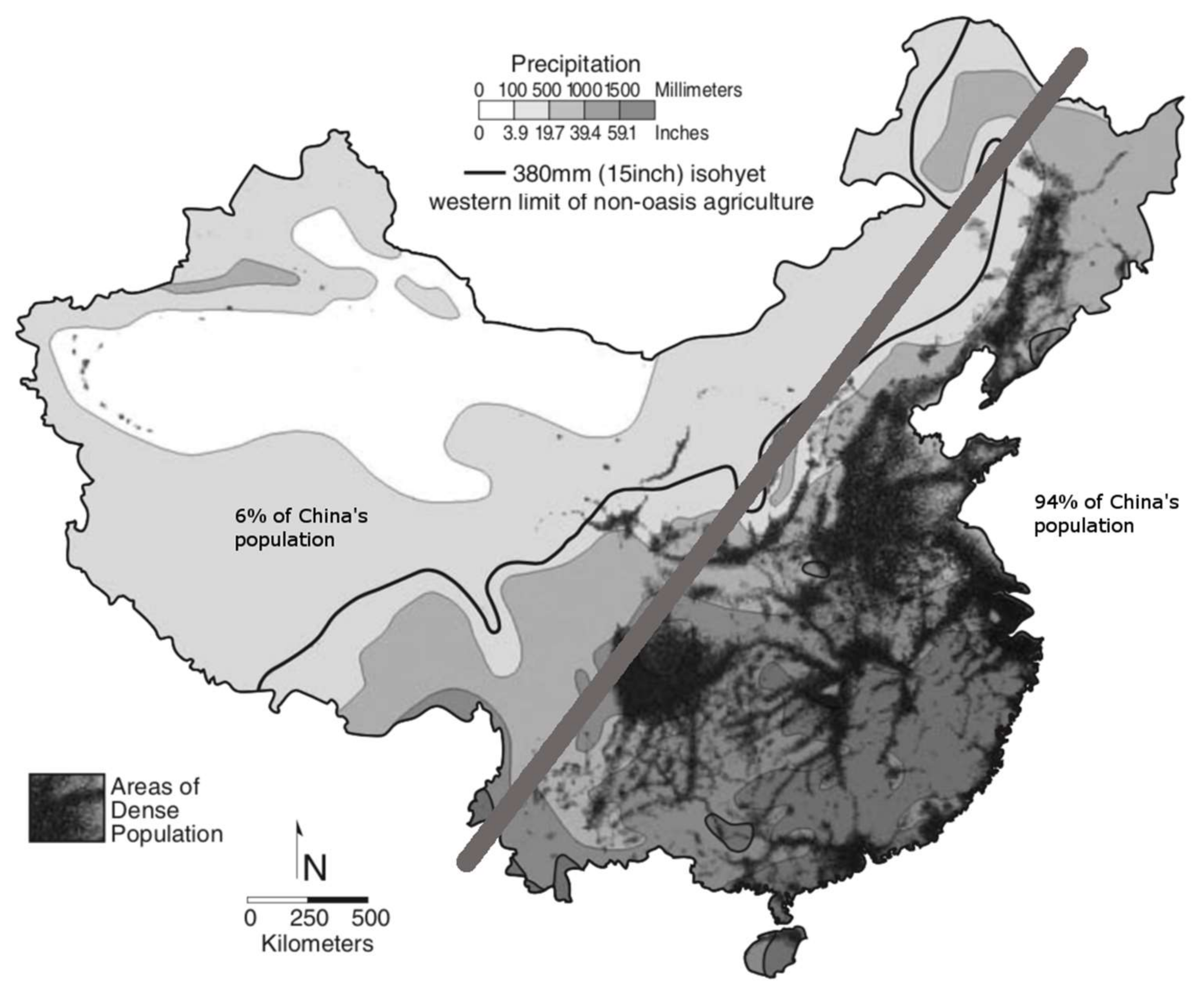
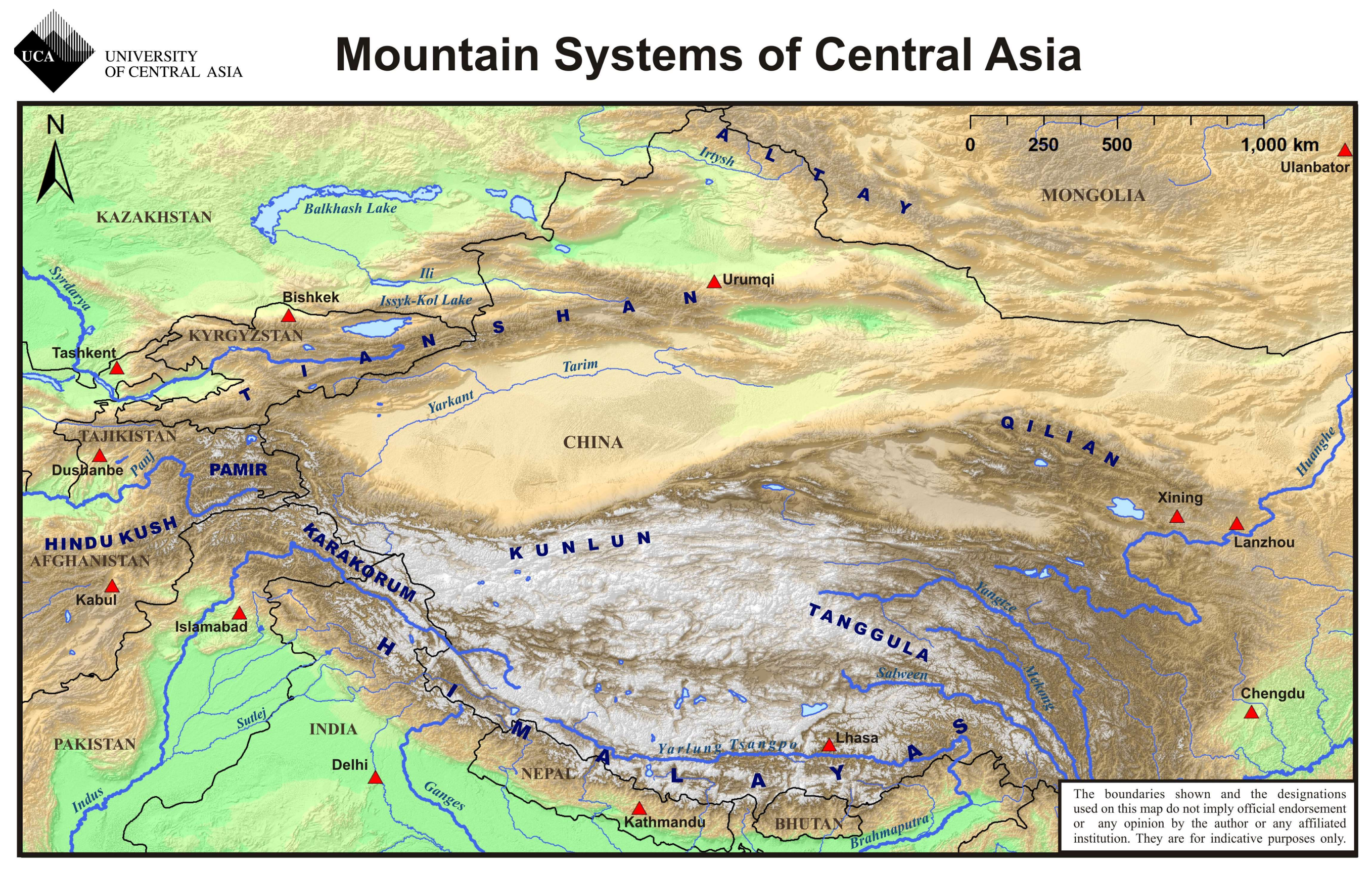
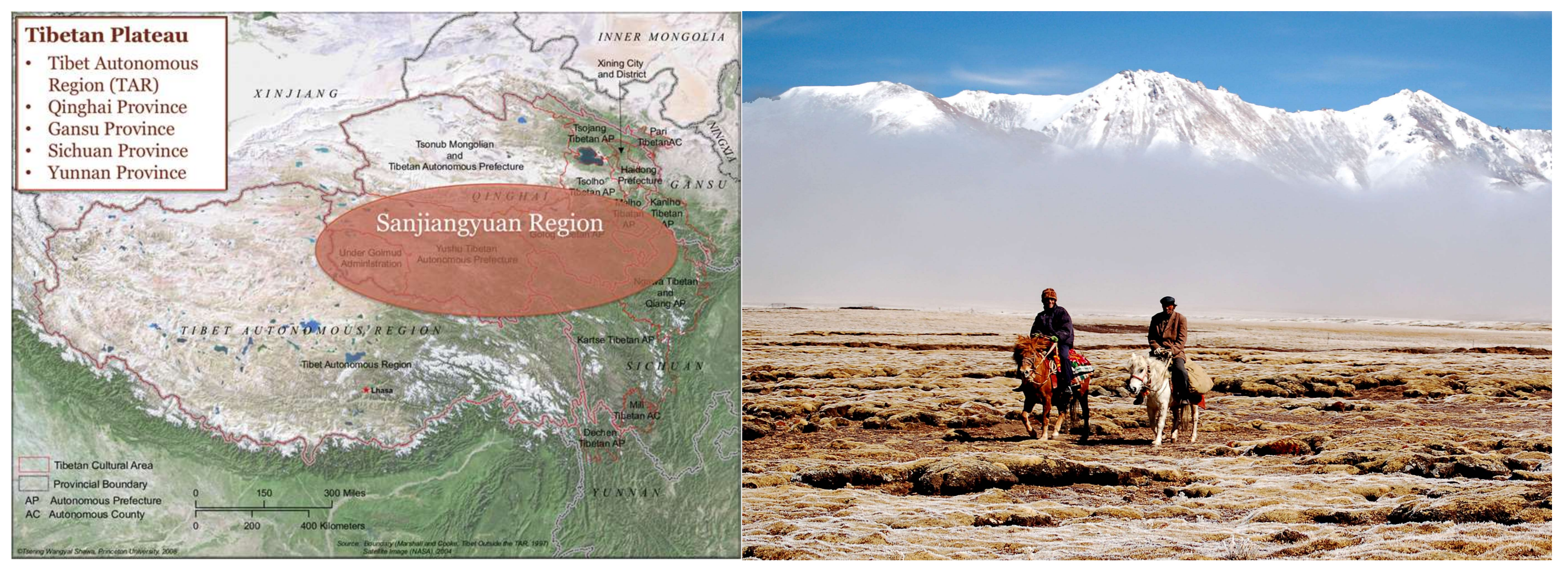
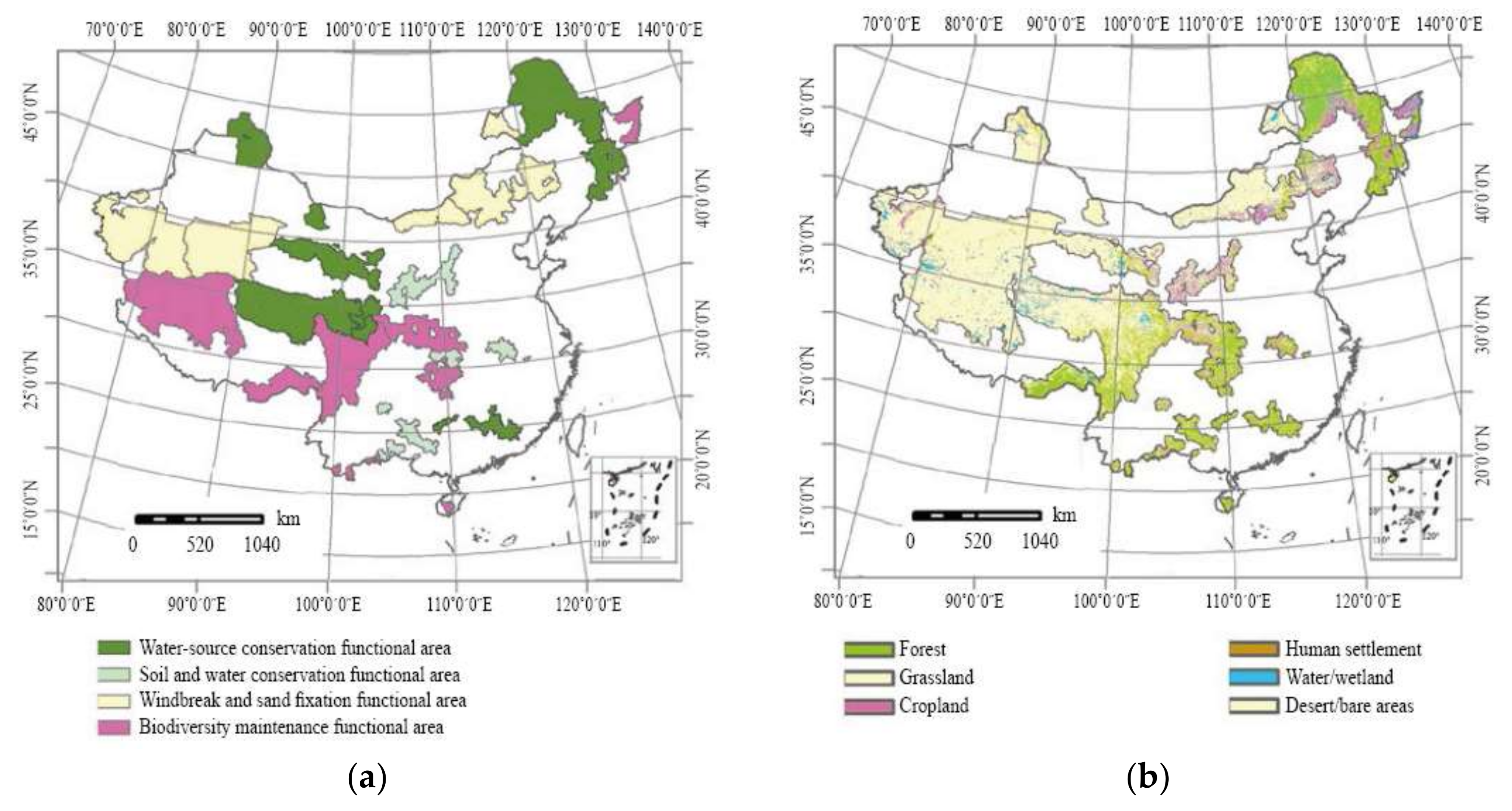
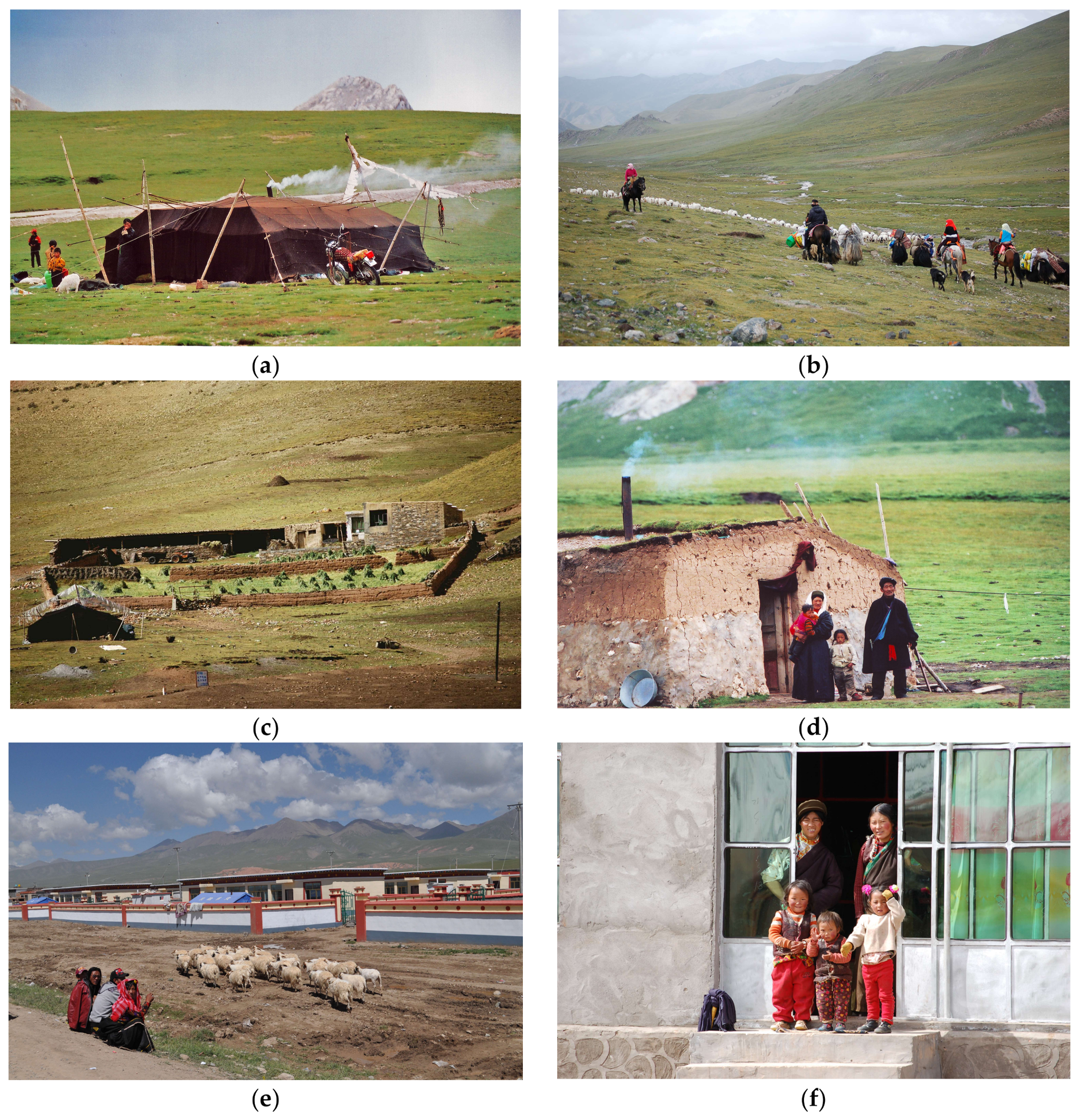
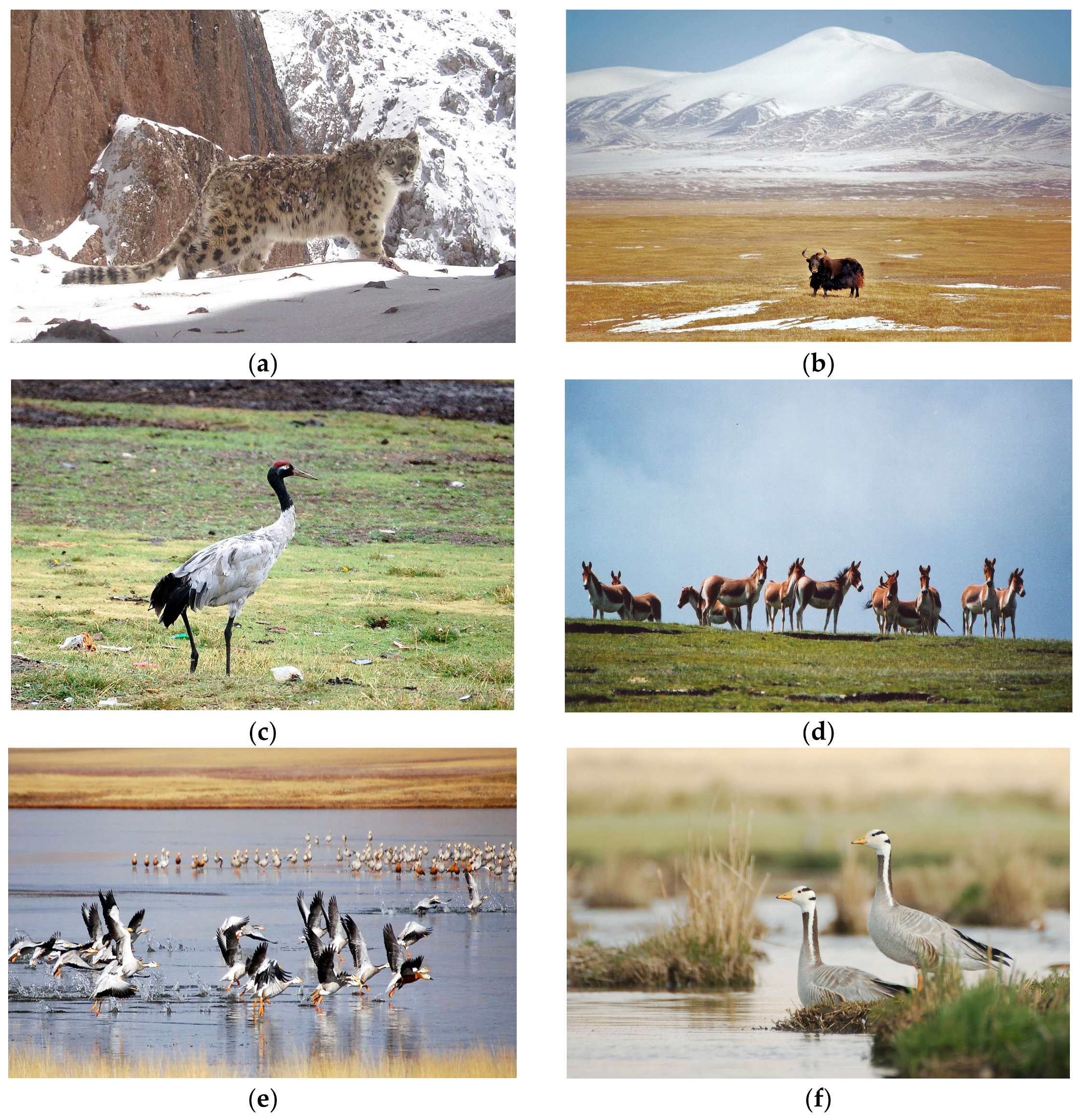


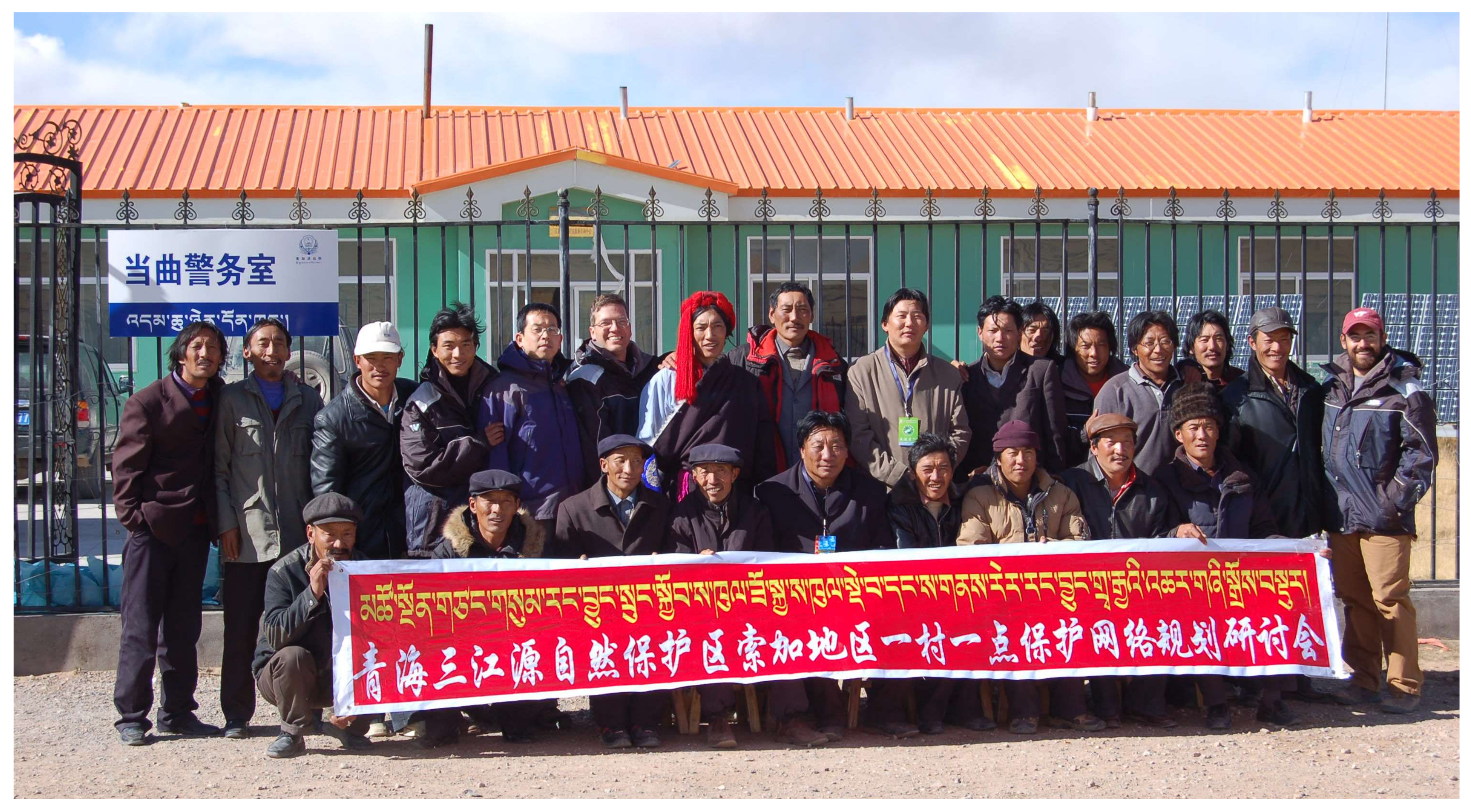
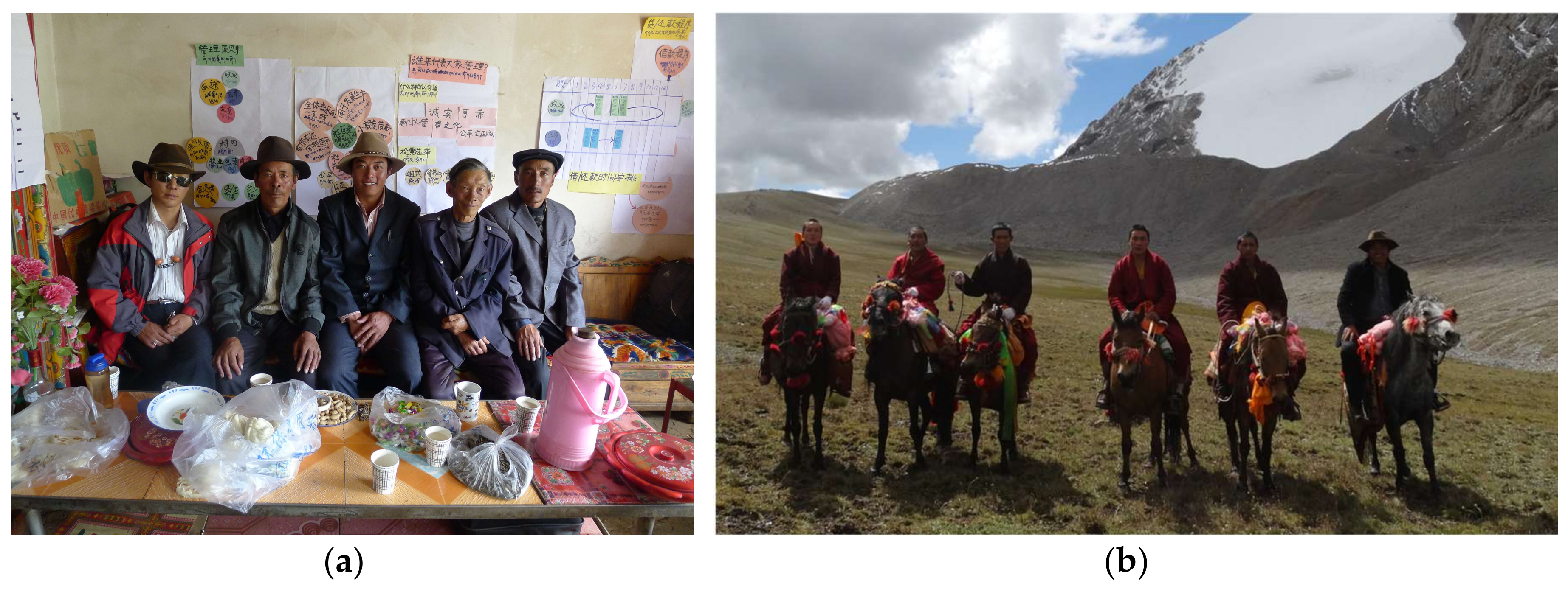

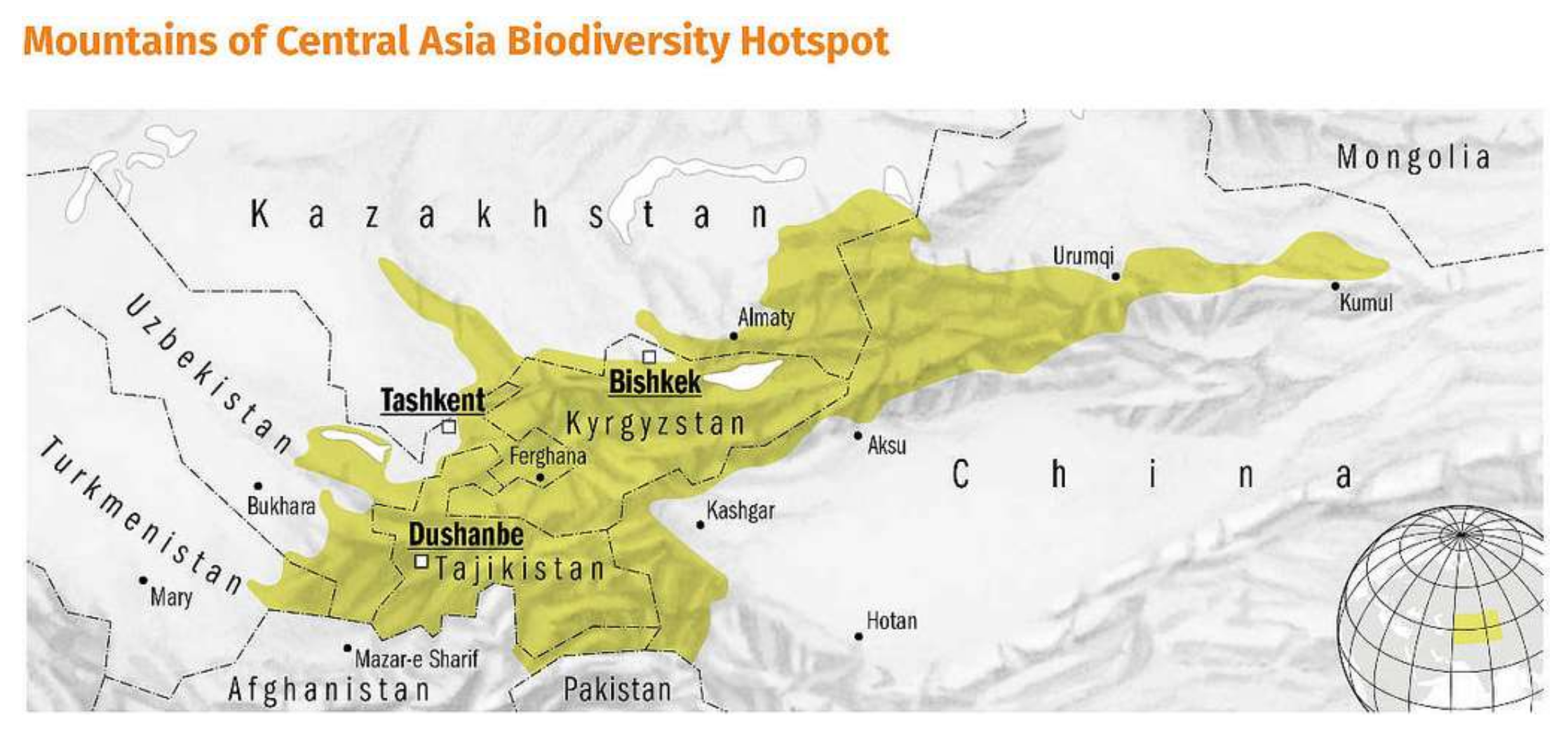
| Name | Province | Description | Total Area |
|---|---|---|---|
| Sanjiangyuan NP | Qinghai | The first and largest of the 10 pilot national parks, encompassing the headwaters of 3 major rivers: the Yellow, Yangtze, and Mekong rivers [88] | 123,100 km2 |
| Great Wall NP | Hebei | The only NP in China that is being built around cultural heritage, 1 including the Ming Dynasty Tombs and Badaling Great Wall [89] | 60 km2 |
| Pudacuo NP | Yunnan | Renowned for its primitive landscape including lakes, wetlands, forests, and meadows, as well as nearly 100 endangered wildlife species. Very rich in biodiversity, it contains over 20 percent of China’s plant species and around 1/3 of its mammals and birds. Home to black-necked cranes, orchids, and Himalayan Yew. Tibetan culture and customs also are component parts of the NP. | 1313 km2 |
| Qianjiangyuan NP | Zhejiang | Includes habitat of threatened endemic species such as Elliot’s pheasant and tufted deer. Known for seed plants. | 252 km2 |
| Mount Wuyi NP | Fujian | Known for deep canyons, dense subtropical forests, waterfalls, and wildlife. One of China’s most famous, beautiful landscapes. A World Heritage Site. 2 | 983 km2 |
| Shennongjia NP | Hubei | Well known for vast primeval forests, large numbers of endangered species and varieties of medicinal herbs, and legends such as the mysterious “Wild Man”. Situated near China’s Three Gorges. Largely karstic, with many caves. A World Heritage Site. 3 | 1170 km2 |
| Mount Nanshan NP | Hunan | Stopping point for tens of thousands of migratory birds. | 619 km2 |
| Siberian Tiger and Siberian Leopard NP | Jilin and Heilongjiang | The park covers one-quarter of the area of the Siberian tiger and Siberian leopard (hubao) habitats in China and over 75% of the animals’ wild population [82,90,91]. | 14,600 km2 |
| Giant Panda NP | Sichuan, Gansu, and Shaanxi | More than 80 protected areas will be incorporated into this park, home to most of the world’s giant pandas (daxiongmao), along with much other wildlife. | 27,000 km2 |
| Qilian Mountains NP | Gansu and Qinghai | High altitude mountain range (at 4000 to 6000 m asl) with meadows, forests, glaciers, and rugged landscape. Home to snow leopard, white-lipped deer, and other rare wildlife species. | 50,000 km2 |
| Major Lessons | for National Parks and Other Protected Areas | for BRI |
|---|---|---|
| Comprehensive perspectives are essential | √ | √ |
| Conservation champions are major players | √ | |
| Community ownership increases commitment | √ | √ |
| Community participation increases effectiveness | √ | √ |
| Community co-management helps to build trust | √ | √ |
| Cooperatives and associations are effective tools | √ | √ |
| Citizen science can serve as a connecting bridge | √ |
© 2018 by the author. Licensee MDPI, Basel, Switzerland. This article is an open access article distributed under the terms and conditions of the Creative Commons Attribution (CC BY) license (http://creativecommons.org/licenses/by/4.0/).
Share and Cite
Foggin, J.M. Environmental Conservation in the Tibetan Plateau Region: Lessons for China’s Belt and Road Initiative in the Mountains of Central Asia. Land 2018, 7, 52. https://doi.org/10.3390/land7020052
Foggin JM. Environmental Conservation in the Tibetan Plateau Region: Lessons for China’s Belt and Road Initiative in the Mountains of Central Asia. Land. 2018; 7(2):52. https://doi.org/10.3390/land7020052
Chicago/Turabian StyleFoggin, J. Marc. 2018. "Environmental Conservation in the Tibetan Plateau Region: Lessons for China’s Belt and Road Initiative in the Mountains of Central Asia" Land 7, no. 2: 52. https://doi.org/10.3390/land7020052
APA StyleFoggin, J. M. (2018). Environmental Conservation in the Tibetan Plateau Region: Lessons for China’s Belt and Road Initiative in the Mountains of Central Asia. Land, 7(2), 52. https://doi.org/10.3390/land7020052




